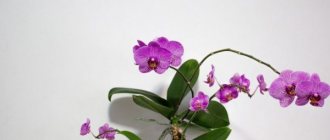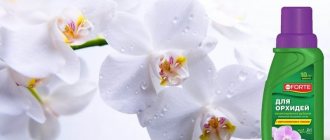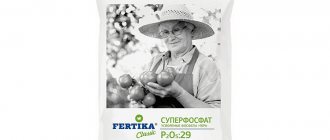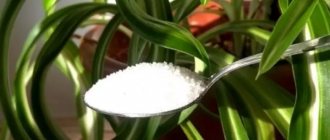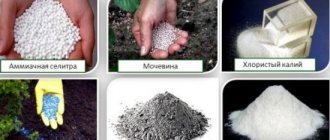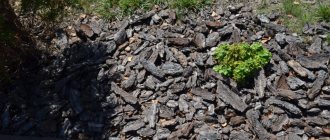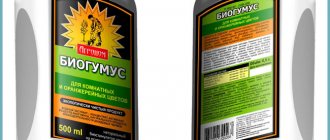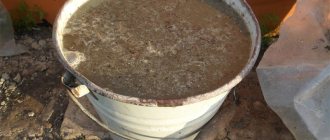need feeding like no other This is explained by the peculiarities of their structure and living conditions.
Skillful feeding is one of the factors in the good condition of the plant, as well as its health and lush flowering. Therefore, the choice of fertilizers should be approached wisely, as well as their application . Failure to comply with the conditions can lead to extremely negative consequences.
General requirements for fertilizers for orchids
The main thing that a novice orchid lover should firmly remember is that epiphytes really do not like overfeeding. Standard complexes for decorative flowering indoor plants are not suitable for them. Such fertilizers are too concentrated, and attempts to “manually” reduce the concentration by doubling or tripling the dilution are not always successful.
The second distinctive feature of orchid nutrition is its low nitrogen requirement. Essentially, if
Fertilizer for orchids: reviews, application. Only healthy orchids can be fertilized. It is very difficult for sick specimens or plants that have recently experienced stress (pruning, moving, infection, pest attack) to absorb fertilizing
plants grow well, they only need maintenance doses of this element. It is possible to increase its content in fertilizing only if leaf growth is clearly inhibited or clear signs of nitrogen deficiency appear.
Unlike fertilizers for other indoor plants, complexes for orchids should contain mainly phosphorus and potassium. But the concentration of these nutrients in them is low. In nature, most orchids grow without soil, clinging to a tree trunk, and some species are even lithophytes - that is, they are attached to stones. Under such conditions, they receive a meager amount of mineral nutrition, and their roots are physiologically unable to absorb large amounts of salts. This must be taken into account when choosing fertilizer.
Important! To feed orchid plants, it is better to choose only specialized fertilizers marked “For orchids”. Even professionals in the field of epiphyte breeding do not like to use universal complexes and even less often experiment with individual salts (urea, superphosphate, etc.). There is no practical need for this, since the choice of ready-made fertilizers for orchids is now quite wide.
Natural features of an orchid
Most orchids are epiphytes, less often lithophytes. They usually grow with their roots attached to a support - a tree trunk or branch. They receive nutrition when, during rain, water washes away various organic matter or mineral substances along the support , which are abundant on the bark of a tree or the surface of a stone.
At the same time, the epiphyte does not parasitize the host plant, that is, it does not suck the juices out of the host. Only a few species of underground orchids lead a parasitic lifestyle. Terrestrial orchids feed like ordinary plants, absorbing the necessary elements from the soil.
Most orchids are epiphytes.
The impetus for development for most tropical species of orchids that interest us in greenhouse and indoor culture is the rainy season . In nature, this is manifested by abundant irrigation, which is accompanied by rich nutrition (substances are often washed off the trees), as well as high levels of relative humidity against a background of elevated temperatures and plenty of light.
Flowering, on the contrary, begins during a period of relative drought , when stable flight of insects that pollinate orchid flowers becomes possible.
Types of fertilizers for orchids: mineral and organomineral
Ready-made fertilizers for orchids are divided into two large groups - mineral and organomineral:
| Fertilizer group | Characteristic | Advantages and disadvantages |
| Mineral | Contain pure mineral compounds consisting of macro- and microelements in the form of salts or acids. | The advantage is simplicity and versatility of use (watering, immersion, spraying). Disadvantage: high risk of overdose if diluted incorrectly |
| Organomineral | They contain microelements in chelated form, often containing vitamins, amino acids, and phytohormones in the formula. | Advantages: higher bioavailability of nutrients and overall effectiveness. Disadvantage: risk of overdose. |
The forms of release of fertilizers for orchids can be as follows:
- liquid concentrates in bottles or ampoules;
- ready-made working solutions in sprays;
- prolonged liquid concentrates in applicators.
The cheapest and most popular options are concentrated solutions in bottles. Sprays and applicators are much more expensive, although they are very convenient to use.
Tip #1. Sometimes you can find fertilizers for orchids on sale in the form of sticks. But practice shows that this is a bad choice. In substrates for epiphytes, which must be dried quickly and completely, the sticks disperse poorly and interfere more with the roots. Moreover, they are not suitable for orchids that are grown without a substrate.
Brief overview of the most popular fertilizers
The modern market is flooded with all kinds of fertilizers from various manufacturers, which are full of bright packaging with “some numbers”.
Additional confusion is caused by conflicting reviews and characteristics that a florist encounters on the Internet. Therefore, it is necessary to clarify the issue of choosing the right one, which ones are good.
Below are the most popular, time-tested and experience-tested fertilizers that have good reviews.
Pokon
Fertilizer from a famous manufacturer comes in two types:
- liquid (NPK 5:6:7) – 250 ml bottles;
- in sticks (NPK 14:7:8) – packs of 24 sticks.
Liquid fertilizer is enough for 200 liters of solution, and one stick is enough for three months, which seems to be a very economical option. They are extremely simple to use: liquid fertilizer is diluted with water in the required proportions and applied with watering, and the sticks are inserted and deepened into the substrate.
Pokon.
In general, fertilizers from this company are high-quality and the most effective of those presented in this review . They are produced in Holland, hence perhaps the only significant drawback - a hostile price tag with teeth - you have to pay for quality.
There is also an “ orchid nutrient spray ” that contains an additional complex of substances that can be used as an additive to fertilizers throughout the year.
Agricola
Fertilizer from a domestic manufacturer – Greenbelt company. Sold in liquid form (NPK 4:5:6) in 250 ml bottles. It is enough for about 50 liters of solution.
Its composition is similar to liquid Pokon, but is inferior in efficiency. Before use, the required amount of fertilizer is diluted in water, after which the solution is applied under the root or the plants are immersed in it as a group.
It is obvious from the composition that the fertilizer is well suited for stimulating the formation of flower buds , however, for active growth, additional application of nitrogen-containing fertilizers will be required. The set includes a measuring cup, which makes manipulation easier. The action is satisfactory, the price is quite affordable.
Bona forte
Manufacturer: Rusinkhim. Domestic, liquid fertilizer (NPK 4:2.5:7). Also contains a complex of vitamins with the addition of succinic acid. Well suited for growing green mass, tops and roots. However, for the confident establishment of flower buds, phosphorus-containing fertilizers will also be necessary. A 285 ml bottle of Bona Forte is enough for 80-100 liters of solution.
By analogy with Pokon, there is a “ leaf tonic ” that can be used as an addition to the main feeding. A good drug, gives excellent results and ensures excellent growth. However, its price will not seem affordable to everyone.
Bona forte.
Joy
Economical, humic organomineral liquid fertilizer produced in Russia. Contains up to 5.4% humic substances and at least 9% potassium. One 250 ml bottle is enough for 250 liters of solution. Diluted in ordinary water.
The composition also includes a complex of microelements necessary for plants. The price is moderate. Well suited for terrestrial orchid species or those that grow in relatively heavy, moisture-intensive substrates . It has an unpleasant odor and an unlimited shelf life.
Joy.
Rainbow
Universal fertilizer Rainbow (NPK 10:10:10) is well suited for most indoor plants, but not for orchids . A 500 ml bottle is enough for 50-60 liters of solution. It can be used as a fertilizer for foliar feeding in a concentration of ½ of the original. The price is affordable.
Advice! All liquid fertilizers must be shaken before use to weigh out the sediment.
Mister color
The result of the work of Ukrainian farmers. Contains macroelements (NPK 1.5:4:2.5), microelements in chelated form, vitamins and amino acids , which enhance the photosynthetic activity of the plant. Suitable for most types of orchids and bromeliads. A 300 ml bottle is enough for 50-60 liters of solution.
It is advisable to fertilize using the immersion method . The price is cheap. In terms of price/quality ratio, it can be considered the best option. The manufacturer recommends combining the fertilizer with the alternative spray “Doctor Foley Orchid” for foliar feeding.
Perfect for use if the collection contains a large number of plants.
In general, fertilizers have a similar composition and the differences may not be as significant as they seem at first glance. First of all, environmental conditions influence the development of a plant, and fertilizers only stimulate it.
Comparative composition of some fertilizers for orchids
Ready-made complexes for orchids may have different ratios of the main nutrients - nitrogen, phosphorus and potassium. Depending on the proportion of these components, the purpose of the fertilizer changes:
| Fertilizer name | NPK proportions | Purpose |
| "Agricola for orchids" | 4:5:6 | For flowering |
| "Bona Forte for orchids" | 4:2,5:7 | To strengthen immunity and root growth |
| "Fasco for orchids" | 3:3:3 | For leaf growth, flowering and overall health improvement |
| "Agrecol for orchids" | 5:5:5 | For leaf growth, flowering and overall health improvement |
| "Crystal for orchids" | 3,8:3,8:4 | For leaf growth, flowering and overall health improvement |
Based on this table, orchid lovers can understand the basic principle by which they need to choose fertilizers. If the composition is low in nitrogen, but high in phosphorus and potassium, the complex is suitable for feeding orchids before flowering and for prolonging it. If the three main components are approximately equal - for feeding at the start of the growing season, during the growth of leaves. With an emphasis on potassium - to increase resistance to adverse factors and for the growth of the root system.
Basic rules for feeding at home
First of all, you need to understand when you can feed the plant and when you can’t. It depends on what particular orchid is grown and under what conditions. So, you can’t feed:
- plants that are dormant (that is, overwinter);
- diseased plants;
- plants after transplantation during the rooting period;
- plants that are in improper living conditions - lack of light, low temperatures, etc.
The use of fertilizers requires care, prudence and accurate calculation , and you must choose the best fertilizer for orchids of the exact type that you are growing.
Tropical species of orchids that do not have a pronounced dormant period and grow in optimal conditions - primarily with sufficient light - can be fed even in winter.
The correct choice of fertilizer dosages remains important. It is recommended to fertilize in half or quarter concentrations of those indicated on the package. This is explained by the fact that epiphytes grow literally with a bare root system, which in this form is very vulnerable. In this case, an aggressive fertilizer solution can burn it.
It is very important to follow the dosage of fertilizers.
Important! Fertilizers can be applied only to moist root systems or soil.
Plants that grow in nature are in a balanced environment, where everything is in a certain balance. Domestic orchids are usually grown in unfriendly conditions in a substrate based on pine bark, that is, very poor in nutrients.
And if in nature the orchid received nutrition thanks to precipitation, then in culture this responsibility must be taken entirely by man. Otherwise, the plant will simply have nowhere to obtain the minerals necessary for normal development.
Almost all fertilizing is vital for orchids. Their correct application can significantly strengthen the plant, increase its immunity and resistance to disease. At the same time, inept or inappropriate use of fertilizers and overdoses can lead to undesirable consequences, including the death of the plant.
Composition of the drugs used
The best solution is to use liquid complex formulations “for orchids” , which include nitrogen, phosphorus in a dominant concentration, and potassium.
These are the three most necessary elements for a plant. They are involved in metabolic processes and nutrition. Their concentration should be lower compared to fertilizers for ordinary indoor plants:
- nitrogen is necessary for proper growth and development, growth of green mass, tops and roots;
- potassium significantly supports plants, making them more resilient to unfavorable conditions and accelerating growth;
- Phosphorus in fertilizing is responsible for the formation of flower buds, the development of peduncles, the growth of buds, flowers and the formation of fruits (pods with seeds).
Applying each element separately requires certain knowledge and experience in handling fertilizers. It is necessary to take into account the composition and moisture of the soil and the condition of the plant. However, this method allows you to quickly fertilize in a more flexible mode, giving the plant exactly what it needs at a certain period.
For the average beginner orchid grower, who is not too sophisticated in knowledge in this area, the best option for feeding orchids would be complex fertilizers, where the composition is already balanced and averaged. Such fertilizers are easy to use; the grower only needs to correctly calculate the dosage.
For beginners, it is better to use complex fertilizers.
Mature, large and healthy plants that are at the peak of seasonal development and growth can be fed at the concentration indicated on the package . In the spring and before the dormant period, the dosage is halved.
Young orchids need to be fed in a dosage that is four times less than that indicated on the package. Very young orchid seedlings or children are fed at a concentration of 1/6 or 1/8. You need to understand that it is much better to apply a small amount of fertilizer, but more often, rather than a large amount with long breaks.
Advice! Alternate mineral fertilizers with organic ones. As well as soaking and watering at the root with spraying on the leaf.
“Pokon for orchids”: description and instructions
In the TOP of the most popular complexes for feeding orchids is a product of the famous Dutch agrochemical. It belongs to classic mineral fertilizers and is produced in the form of a liquid concentrate, packaged in 250 ml bottles. The price per bottle is about 215 rubles.
In addition to the basic nutrients, this supplement contains the following minerals:
- boron;
- manganese;
- iron;
- zinc;
- copper;
- molybdenum. It is recommended to fertilize with Pokon fertilizer taking into account the season: in spring and summer – once a week, in winter – once every 2 weeks. For leaf spraying, you can prepare a less concentrated solution than for root spraying: 2.5 ml of concentrate per 1 liter of water
The NPK proportion in this complex is composed with an emphasis on potassium and phosphorus - 5:6:7. It contains nitrogen in three forms at once - nitrate, ammonium and amide. This allows you to apply “Pokon” both at the root and along the leaf. Fertilizer is diluted at the rate of 5 ml per 1 liter of water, so the bottle is enough to prepare 50 liters of working solution.
“I use almost nothing except Pocon, and my orchids are doing great. I don’t always adhere to the regimen that is written in the instructions; I feed intuitively when I feel it’s time. With this fertilizer, some phalaenopsis began to produce 2 flower stalks at a time. I don’t notice any shortcomings or side effects” (Marina, Volgograd).
Reviews of Bona forte
In general, the drug Bona Forte has positive reviews. Below are a few of them:
Tatiana. “I was given an orchid for my birthday, then I learned what a whimsical flower is. In addition to constantly adjusting the temperature and humidity level, I was faced with the choice of fertilizer. The flower shop recommended the domestic Bona Forte “Beauty”. It's relatively inexpensive. I diluted it according to the instructions, watered it once a week during the period of active growth. The result simply amazed me: my orchid threw out several flower stalks with a huge number of buds. Soon, thanks to this fertilizer, I achieved repeated flowering.”
Pauline. “I used Bona Forte to feed my Phalaenopsis. I have had it for a very long time, but somehow over time it began to bloom poorly. I bought a fertilizer solution at the store and prepared it in two ways. The first time I carried out root watering (immersed the pot in a solution with fertilizer for 30 minutes). A week later, using the foliar watering method, I fed the orchid again. A month later, my Phalaenopsis released a flower stalk with 8 buds! I think the only drawback is the unpleasant smell of the concentrate.”
"Doctor Foley Orchid": composition features and reviews
One of the best fertilizers in spray form is “Doctor Foley Orchid” from the Ukrainian company “Gilea”. There is no need to dilute it in any way; the solution is completely ready for use. But orchid lovers fell in love with it not for this, but for its perfectly selected composition. In addition to the standard set of macro- and microelements that can be found in other complexes, Doctor Foley contains biologically active substances:
- amino acids – glycine, tryptophan, saponin, agrinin;
- vitamins – all group B and PP;
- phytohormones – gibberellins, auxin, cytokinin.
In essence, Doctor Foley Orchid is a fertilizer with powerful stimulating and revitalizing potential. But even on problem-free specimens it shows a good effect, increasing the quality and duration of flowering:
Sprays are used exclusively on leaves. It is impossible to spray the inflorescences with fertilizers, and the axils of the leaves after application should remain dry, without accumulating the drained solution.
“I really loved the Dr. Foley sprays. Some of my orchids sit on the north window, and they have an eternal problem with leaving dormancy and getting sores. I use it in turn, at the start - “Doctor Foley Starter”, and closer to flowering - “Doctor Foley Orchid”. I spray the leaves and all the roots that stick out from the pot. The condition is noticeably improving, flowering is normal” (Albina, Moscow).
Doctor Foley Starter fertilizer is not designed specifically for epiphytes; it can be used for any indoor flowers. But if the orchid “stays too long” and does not want to produce young leaves, its one-time use will not harm. The average cost of both formulations is 150 rubles per bottle.
“REASIL for orchids”: description, reviews and instructions
Of the organomineral complexes for orchids, experts most often recommend “REASIL” - an innovative chelate complex with very high resistance to sunlight. This feature sets it apart from other chelated fertilizers, which can quickly disintegrate in light. And since orchids have not only leaves under light, but also roots, this property can be considered a serious advantage.
The proportion of macroelements in the REASIL fertilizer for orchids is shifted towards potassium and balanced in nitrogen and phosphorus - 6:6:10. In addition to these main components, the composition contains the following:
- microelements in the form of chelates - iron, copper, boron, manganese, zinc, molybdenum, cobalt, calcium, magnesium;
- vitamins – C and group B;
- organic acids – succinic, citric;
- amino acids – L-lysine.
Judging by the reviews of plant growers, “REASIL for orchids” almost works wonders:
"REASIL" is one of the most economical fertilizers for orchids. A 250 ml bottle costs only 90-100 rubles. Taking into account the low consumption of concentrate when preparing the working solution, this container is enough for 250 liters of ready-made fertilizer
“In the summer they gave me a phalaenopsis, and it bloomed all summer. When the flowers began to fall in the fall, I decided to try feeding it so that it would continue to bloom. I bought “Reasil for orchids”, watered it and soon noticed that new flower buds began to grow at the tip of the peduncle. I started feeding her with Reasil once a month. After the top of the peduncle has bloomed, the lower side buds begin to grow. It turns out that my phalaenopsis is not going to retire yet” (Elena, Bryansk).
“REASIL for orchids” is available in the form of a liquid concentrate and is diluted 1 ml per 1 liter of water for root feeding. For leafy ones, the concentration is half as much, 1 ml per 2 liters of water. In spring and summer, orchids are fertilized with this solution once every 2 weeks, in autumn and winter - once a month.
When and how often to fertilize?
Before applying the drug, you need to study the following factors : time of year, soil composition and its condition. Fertilizers need to be applied when the grower notices the following changes in the development of the orchid:
- Various microorganisms and fungi appeared in the substrate, which feed on the plant itself.
Sometimes such organisms accumulate due to frequent application of fertilizers. Therefore, you must strictly adhere to the instructions for using fertilizer. And also reduce the dosage for adult perennial plants. - After transplanting into homemade soil. This plant requires fertilizing with nitrogen.
- In case the ground is saturated with polystyrene foam or other synthetic substances.
- In the autumn-winter period, you need to fertilize the thicket no more than once or twice a month. Since this time is considered a time of rest, the orchid grows slowly, and therefore requires less fertilizer.
- With the onset of spring, fertilizing should be increased up to three times a month. Spring is a time of awakening, so all processes accelerate.
Important! At the end of summer, feeding is again reduced to once a month.
The problem of using organic fertilizers for orchids
Some manufacturers also produce organic fertilizers for orchids in the form of humates or vermicompost. Growers who are accustomed to crops growing in soil are very tempted to buy these complexes. However, it is better not to do this.
Indeed, vermicompost and various humates are an excellent and completely safe alternative to mineral fertilizers. But their task is to increase natural soil fertility. For epiphytes, this type of fertilizer is not only useless, but also harmful. The problem is that humic acids activate microflora, which decomposes organic residues. Therefore, the substrate for orchids under their influence very quickly turns into dust.
Fertilizer for orchid flowering: what and why
This flower, like no other, loves stability and constancy. Growing for hundreds and even thousands of years in the same conditions, it reacts negatively to sudden changes in humidity or ambient temperature, lighting conditions and many other factors. Such deviations from the usual environment can cause illness and even completely destroy the flower. Therefore, fertilizers for orchids, including the famous and mega-popular phalaenopsis today, should be selected carefully and carefully, and applied according to all the rules so as not to harm delicate plants.
Important
Any gardener who has previously had experience in growing orchids can say with confidence that artificial feeding does not become vital for him or cause active growth and abundant flowering. The overseas beauty receives the bulk of its nutrients and microelements from air and moisture, so no fertilizer for orchids can be called necessary.
Despite the fact that fertilizer for orchids for flowering is not considered necessary, that is, to bloom, with the right maintenance regime and proper care, they will do so. However, in order to make growth active and flowering abundant, it won’t hurt to think about additional feeding.
Expert advice on choosing fertilizer for orchids
When choosing fertilizer for their orchids, amateur plant growers can rely on the general recommendation given by experienced experts in this field:
“You don’t need to stock up on a lot of fertilizer. All you have to do is choose one. Let it be the simplest “Agricola for orchids” or some kind of chelate complex. Additionally, in the “orchid grower’s first aid kit” you can purchase succinic acid and a good resuscitator - for example, “Ribav-Extra”. This is quite enough for successful breeding of orchids.”
A. Davydovskaya, owner of the greenhouse
